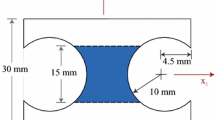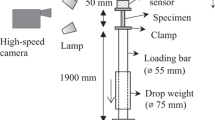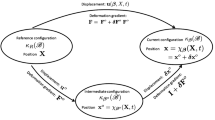Abstract
Inferring material parameters of soft materials, especially soft tissues from experiments, has always been a challenge because of the inaccuracy of specimen geometry, difficulty in proper gripping and difficulty in obtaining reliable displacement data. If one is able to obtain full field data with Digital Image Correlation or other similar techniques, we show that in spite of poor quality experimental data, it is still possible to get the material parameters using Virtual Fields Method with carefully chosen virtual fields. We demonstrate the approach by two cases. The first is Ecoflex (silicone rubber) under biaxial deformations at controlled loading rates, and the second is rat skin samples with imperfect shape under biaxial deformations at controlled loading rates. In both cases, rather than trying to obtain homogeneous deformation conditions, we use a technique based on the Virtual Fields Method to extract the material properties from the deformation of the specimen collected by Digital Image Correlation (DIC) and the force load measured by the load sensor. In order to apply loads in two principal directions simultaneously, a custom biaxial set-up was built and mounted into a uniaxial Instron tensile set-up. We show here that in spite of significant inhomogeneity in the deformation, errors, and missing data in the measured displacement field, we are still able to recover the material properties of the soft solid by suitable choices of virtual fields.





















Similar content being viewed by others
References
Afsar-Kazerooni N, Srinivasa A, Criscione J (2020) Experimental investigation of the inelastic response of pig and rat skin under uniaxial cyclic mechanical loading. Exp Mech pp. 1–17
Avril S, Badel P, Duprey A (2010) Anisotropic and hyperelastic identification of in vitro human arteries from full-field optical measurements. J Biomech 43(15):2978–2985
Avril S, Grédiac M, Pierron F (2004) Sensitivity of the virtual fields method to noisy data. Comput Mech 34(6):439–452
Benias PC, Wells RG, Sackey-Aboagye B, Klavan H, Reidy J, Buonocore D, Miranda M, Kornacki S, Wayne M, Carr-Locke DL et al (2018) Structure and distribution of an unrecognized interstitium in human tissues. Sci Rep 8(1):4947
Berardesca E, Elsner P, Wilhelm KP, Maibach HI (1995) Bioengineering of the skin: methods and instrumentation, vol 3. CRC Press, Boca Raton
Billiar KL, Sacks MS (2000) Biaxial mechanical properties of the natural and glutaraldehyde treated aortic valve cusp-part i: experimental results. J Biomech Eng 122(1):23–30
Brieu M, Diani J, Bhatnagar N (2006) A new biaxial tension test fixture for uniaxial testing machine-a validation for hyperelastic behavior of rubber-like materials. J Test Eval 35(4):1–9
Capek L, Lochman Z, Dzan L, Jacquet E (2010) Biaxial extensometer for measuring of the human skin anisotropy in vivo. In: 2010 5th Cairo International Biomedical Engineering Conference, pp. 83–85. https://doi.org/10.1109/CIBEC.2010.5716059
Evans SL, Holt CA (2009) Measuring the mechanical properties of human skin in vivo using digital image correlation and finite element modelling. J Strain Anal Eng Design 44(5):337–345. https://doi.org/10.1243/03093247JSA488
Flynn D, Peura G, Grigg P, Hoffman A (1998) A finite element based method to determine the properties of planar soft tissue. J Biomech Eng 120(2):202–210
Fung YC (2013) Biomechanics: mechanical properties of living tissues. Springer Science & Business Media, Berlin
Geerligs M (2006) In vitro mechanical characterization of human skin layers: stratum corneum, epidermis and hypodermis. Ph.D. thesis, Ph. D. Thesis, Technische Universiteit Eindhoven
Grédiac M, Pierron F (1998) At-shaped specimen for the direct characterization of orthotropic materials. Int J Numer Methods Eng 41(2):293–309
Grédiac M, Pierron F (2004) Numerical issues in the virtual fields method. Int J Numer Methods Eng 59(10):1287–1312
Grediac M, Pierron F, Avril S, Toussaint E (2006) The virtual fields method for extracting constitutive parameters from full-field measurements: a review. Strain 42(4):233–253
Grédiac M, Toussaint E, Pierron F (2002) Special virtual fields for the direct determination of material parameters with the virtual fields method. 1—-principle and definition. Int J Solids Struct 39(10):2691–2705
Grédiac M, Toussaint E, Pierron F (2002) Special virtual fields for the direct determination of material parameters with the virtual fields method. 2—-application to in-plane properties. Int J Solids Struct 39(10):2707–2730
Haut R (1989) The effects of orientation and location on the strength of dorsal rat skin in high and low speed tensile failure experiments. J Biomech Eng 111(2):136–140
Holzapfel GA, Gasser TC, Ogden RW (2000) A new constitutive framework for arterial wall mechanics and a comparative study of material models. J Elast Phys Sci Solids 61(1):1–48
Kazerooni NA, Srinivasa A, Freed A (2019) Orthotropic-equivalent strain measures and their application to the elastic response of porcine skin. Mech Res Commun 101:103404
Kim JH, Avril S, Duprey A, Favre JP (2012) Experimental characterization of rupture in human aortic aneurysms using a full-field measurement technique. Biomech Model Mechanobiol 11(6):841–853
Lanir Y, Fung Y (1974) Two-dimensional mechanical properties of rabbit skin—i. experimental system. J Biomech 7(1):29–34
Lanir Y, Fung Y (1974) Two-dimensional mechanical properties of rabbit skin—ii. experimental results. J Biomech 7(2):171–182. https://doi.org/10.1016/0021-9290(74)90058-X
Maiti R, Gerhardt LC, Lee ZS, Byers RA, Woods D, Sanz-Herrera JA, Franklin SE, Lewis R, Matcher SJ, Carré MJ (2016) In vivo measurement of skin surface strain and sub-surface layer deformation induced by natural tissue stretching. J Mech Behav Biomed Mater 62:556–569
Marek A, Davis FM, Rossi M, Pierron F (2018) Extension of the sensitivity-based virtual fields to large deformation anisotropic plasticity. Int J Mater Form. https://doi.org/10.1007/s12289-018-1428-1
McGrath JA, Uitto J (2010) Anatomy and Organization of Human Skin, Chap. 3, pp. 1–53. Wiley-Blackwell . https://doi.org/10.1002/9781444317633.ch3
Mooney M (1940) A theory of large elastic deformation. J Appl Phys 11(9):582–592
Nolan D, Gower A, Destrade M, Ogden R, McGarry J (2014) A robust anisotropic hyperelastic formulation for the modelling of soft tissue. J Mech Behav Biomed Mater 39:48–60. https://doi.org/10.1016/j.jmbbm.2014.06.016
Rivlin RS (1948) Large elastic deformations of isotropic materials. iv. further developments of the general theory. Philos Trans R Soc Lond A: Math, Phys Eng Sci 241(835): 379–397. https://doi.org/10.1098/rsta.1948.0024. http://rsta.royalsocietypublishing.org/content/241/835/379
Sacks MS (2000) Biaxial mechanical evaluation of planar biological materials. J Elast Phys Sci Solids 61(1):199. https://doi.org/10.1023/A:1010917028671
Seibert H, Scheffer T, Diebels S (2014) Biaxial testing of elastomers-experimental setup, measurement and experimental optimisation of specimen’s shape. Tech Mech 34(2):72–89
Shergold OA, Fleck NA, Radford D (2006) The uniaxial stress versus strain response of pig skin and silicone rubber at low and high strain rates. Int J Impact Eng 32(9):1384–1402. https://doi.org/10.1016/j.ijimpeng.2004.11.010. http://www.sciencedirect.com/science/article/pii/S0734743X04002325
Sommer G, Haspinger DC, Andrä M, Sacherer M, Viertler C, Regitnig P, Holzapfel GA (2015) Quantification of shear deformations and corresponding stresses in the biaxially tested human myocardium. Ann Biomed Eng 43(10):2334–2348. https://doi.org/10.1007/s10439-015-1281-z
Tonge TK, Atlan LS, Voo LM, Nguyen TD (2013) Full-field bulge test for planar anisotropic tissues: Part i-experimental methods applied to human skin tissue. Acta Biomater 9(4):5913–5925. https://doi.org/10.1016/j.actbio.2012.11.035
Toussaint E, Grédiac M, Pierron F (2006) The virtual fields method with piecewise virtual fields. Int J Mech Sci 48(3):256–264
Yin FC, Strumpf RK, Chew PH, Zeger SL (1987) Quantification of the mechanical properties of noncontracting canine myocardium under simultaneous biaxial loading. J Biomech 20(6):577–589
Zemánek M, Burša J, Děták M (2009) Biaxial tension tests with soft tissues of arterial wall. Eng Mech 16(1):3–11
Acknowledgements
The authors gratefully thank Dr. Terry Creasy for allowing us to use his facilities and Dr. Goenezen for lending us, the DIC set-up.
Author information
Authors and Affiliations
Corresponding author
Additional information
Publisher's Note
Springer Nature remains neutral with regard to jurisdictional claims in published maps and institutional affiliations.
Rights and permissions
About this article
Cite this article
Kazerooni, N.A., Wang, Z., Srinivasa, A.R. et al. Inferring material parameters from imprecise experiments on soft materials by virtual fields method. Ann. Solid Struct. Mech. 12, 59–72 (2020). https://doi.org/10.1007/s12356-020-00062-8
Received:
Accepted:
Published:
Issue Date:
DOI: https://doi.org/10.1007/s12356-020-00062-8




